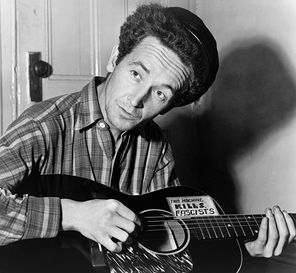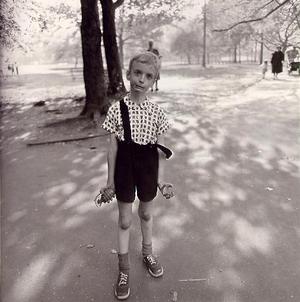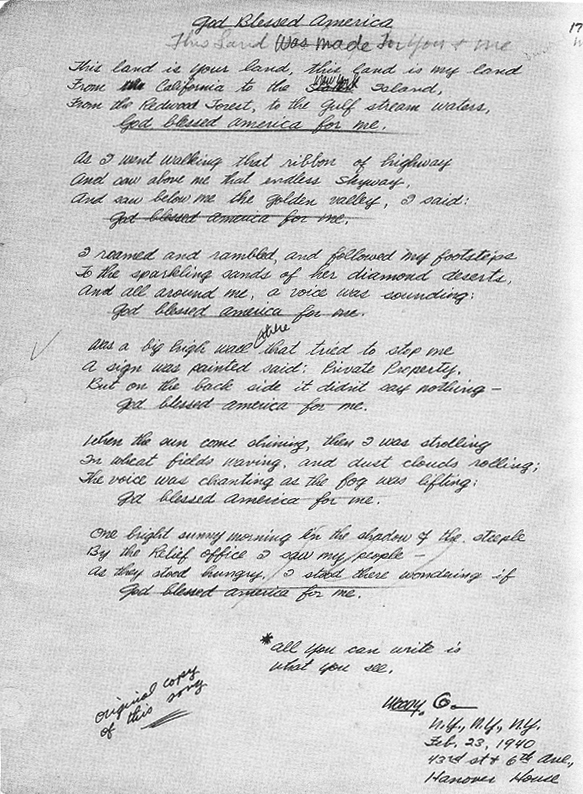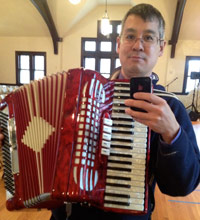 Happy birthday, Woody! Happy birthday, Woody! To mark the centennial anniversary of Woody Guthrie's birthday, Newton's own Tom Ashbrook recently devoted an hour of his On Point show on WBUR to an examination of the importance of Guthrie's "This Land Is Your Land:" Woody Guthrie wrote “This Land is Your Land” in a nothing-special hotel in New York, in the middle of writing a bunch of other songs. Wrote it longhand in a child’s school composition notebook. It sat in that notebook for years. It’s not clear he thought much of it... But it got out, into school songbooks around the country. And took off, like a second national anthem. The podcast traces the fascinating history of this iconic song, how it was sanitized for school kids in the 1950's by the removal of the "secret" verses, so as not to offend the sensibilities of the anti-communists that dominated the discourse at the time. Here are the verses that don't appear in most elementary school songbooks:
Listen to Gutherie’s original recording: While the “schoolhouse” version of the song still maintained the verses that celebrated the beauty of the country, in Guthrie’s plainspoken poetry, it clearly didn’t communicate the nuanced view that Guthrie had of the America he had seen up close, “From California to the New York Island.” As a traveling minstrel, Guthrie criss-crossed America during the 193o’s and 1940’s and saw both the grandeur and the injustice that made America such a contradictory and complex country, a country full of promise and problems, one that Guthrie loved dearly, and was still yet to fulfill the promise of its founding principles. Roots Interestingly, Guthrie lifted the melody and chord progression directly from The Carter Family’s “When the World’s On Fire,” This practice reflects an age-0ld tradition where folk music literally belongs to the people, and anyone can take a song and make it new by writing new lyrics to make it current again. Hard to believe that, in this age of copyright lawsuits, when people are sued for thousands of dollars if they dare to download a copy of a song they like, that a musician like Guthrie would encourage others to take his music and update his lyrics to their own use, the way he did with the original Carter Family tune, and in fact the way every musician before him and since crafts songs by drawing on a tradition of music and a wellspring of songs and melodies that their musical predecessors have given the world. Hidden in Plain Sight It’s fascinating to hear how Guthrie’s work was kept alive and vital through the work of his son, Arlo, and his protogee, Pete Seeger, as they both continued to sing Woody’s songs to audiences that never had a chance to hear Woody Guthrie sing them himself. Even as Pete Seeger was driven out of the “mainstream media” in the 1950’s by the same clique of anti-communists that found the sentiments of Guthrie’s “secret verses” intolerable, he continue to sing to school kids, churches, and union halls, keeping the song alive in its full form, a reminder that, even if you can’t play your music on the TV or the radio, no one can stop you from picking up your guitar and joining your voices in harmony wherever people may gather and meet. At the same time, millions of kids sang the “safe” version of Guthrie’s song in schools across the country, so the strains of the melody would be forever embedded in their unconscious, ready for the time when the whole song, all the verses, could be sung aloud, still ringing with meaning and relevance. For now, almost 80 years after Woody Guthrie first wrote the words to “This Land is Your Land” in his neat, precise penmanship, we face many of the same problems that he knew from firsthand experience: massive disparities between the rich and the poor, a financial and political system that serve the interests of a narrow elite, increasing hardship and suffering for the majority of Americans while a few gorge themselves on power and privilege, and a sense that the country has perhaps lost its way, lost sight of the ideals that animated our rise from a few tenuous colonies on the edge of a vast and mysterious wilderness to a world-spanning colossus that espoused freedom and democracy as an antidote to tyranny and oppression. His lyrics still ring true today, reminding us how much work still remains for us to reach those lofty goals, yet how much hope and beauty we can find just by looking out to our “endless skyway.” Guthrie understood that the people of this country, be they poor, hungry, dispossessed, are still the greatest strength and hope, that our freedom to savor the splendor of our nation connects us to the country’s founding principles, and protects us still from the tyranny of unchecked power and wealth: “Nobody living can ever stop me, / As I go walking that freedom highway.” For this reason, Guthrie’s song remains an anthem that’s just as relevant today as it was when he wrote it on February 23, 1940, a song of protest and solidarity for every American who longs for a day when words like “freedom and justice for all” are more than just a far off ideal or a fairy tale from a history book. Some Other Versions You May Enjoy Guest Tom Morello, guitarist from Rage Against the Machine, sings This Land and strums his acoustic, as he does at many Occupy rallies across the nation (warning: contains naughty words): Springsteen, in the middle of the Reagan years, sings a poignant version at the height of his career: Pete Seeger and Springsteen, in Washington DC, sing all the verses, with everyone helping out: To hear many other Woody Guthrie songs, with others from the American songbook, join us on May 6 at our spring concert. Terry Gross recently had a long interview with Carole King on Fresh Air, where they discussed becoming a songwriter, Gerry Goffin (King’s writing partner and ex-husband), and King’s life in music. It’s worth listening to. To put the conversation in a bit of context, Gross wanted to be a songwriter when she was younger, and King was just a few years older and from around the same neighborhood. One thing King doesn’t talk about in that interview is how she became a performer: she moved to Los Angeles (Laurel Canyon, specifically) and was part of James Taylor’s band. JT encouraged her to sing her songs on stage as part of their set.
Taylor recorded King’s song “You’ve Got a Friend” (and played guitar on her recording of it on Tapestry). On their recent reunion album “Live at the Troubadour,” Taylor says, to introduce the song:
For an altogether weirder, fictional take on King’s world, you can check out the Alison Anders movie “Grace of My Heart” (IMDb, Wikipedia) which follows a songwriter through a tumultuous marriage and eventual success on stage. The movie’s a bit goofy, but if you know the people who made pop music in that era, it’s fun to see how they are fictionalized. In fact, Pete inspired me (Jack Cheng) to write an article about him which was published in the Newton TAB this week. This is how it starts:
Pete Seeger turns 93 on May 3. He is known as a songwriter for writing songs as well-known as “Where Have All the Flowers Gone” and “Turn, Turn, Turn,” as an advocate of folk music for popularizing and adapting the songs of others, like “Oh, When the Saints” and “Hine Ma Tov,” as a performer with The Weavers and in numerous solo recordings, and as the author of a number of books of songs and musical instruction. He is surely all of those things, but I think his primary influence has been as a music enthusiast, encouraging all of us to pick up an instrument, open our mouths and sing. Read more The main thrust of the article is that Seeger inspired a few of us to create a family singing group, and inspired more of us to join and have weekly fun, singing and playing songs together. He also, along with his friend Woody Guthrie, inspired Andy Rogovin to write a beautiful new song called "Pete and Woody." Our musical director Chris Eastburn added some great vocal arrangements to the song, alluding to some of Pete and Woody's best known songs. The world premiere presentation of "Pete and Woody" will be at our concert on Sunday May 6, 2012 at the Memorial Spaulding school in Newton. Teach Your Children was written by Graham Nash for his band, The Hollies. Yep. The Hollies never got around to recording it and so he brought the song to his next band, Crosby, Stills and Nash. The trio recorded the song but when it was released in 1970, the band had added Neil Young so the album was CSNY's "Deja Vu," but Young doesn't play on the song. In fact, here's a nice version by Crosby Nash (no Stills or Young):  Nash's first photo acquisition Nash's first photo acquisition From the liner notes of their 1991 boxed set, Nash writes: The idea is that you write something so personal that every single person on the planet can relate to it. Once it's there on vinyl it unfolds, outwards, so that it applies to almost any situation. Clearly, the song had autobiographical meanings for him. I didn't find anything specifically about the song, but in this 1974 Rolling Stone interview, Nash talks about his father. The elder Nash bought a camera from a friend. The police showed up and claimed the camera was stolen property and demanded Nash's father to reveal who had sold it to him; when he refused, he was sent to prison for a year. Nash claims the episode so shamed his father, it essentially caused his death. Somewhat ironically, given the significance of a camera in his father's demise, Nash is a proficient photographer, as well as a collector of photographs. The first photograph he bought was Diane Arbus' "Child with a toy hand grenade in Central Park, NYC 1962"; as he explained in a 2006 interview with the San Diego Union-Tribune, he had just recorded Teach Your Children and the sight of a boy with toy weapons seemed to encapsulate what he was trying to say with his song. He eventually collected so many photographs, he hired a curator and in 1990 sold the collection at auction at Sotheby’s. Nash goes on in those 1991 liner notes:
The country beat helps, but so does that pedal steel guitar. That’s not any of the band members, but instead a friend who traded his time in exchange for harmony lessons for him and his bandmates. The friend? Jerry Garcia of the Grateful Dead. If you want to know what Garcia was playing, you can see it here: http://www.youtube.com/watch?v=l6dcGA8pkUs What? You missed it? This video teaches you exactly what to play, (although I have no idea what he’s talking about). (Crappy) audio only of the second season episode of The Office “Take Your Daughters to Work Day” featuring Dwight and Michael singing Teach Your Children: Here’s a listenable version featuring Kathy Mattea and Suzy Bogguss on vocals at the Grand Ole Opry (Mattea and Bogguss recorded the song with Nash as The Red Hots for the charity album “Red, Hot and Country”): One Response to Teach Your Children: Graham Nash, photos, and the Grateful DeadWe have some information about Neil Young’s Sugar Mountain from fellow Canadian singer-songwriter Joni Mitchell. From a concert where she was singing a duet (familiar with Newton Family Singers): She introduces her next song by saying:
The song she wrote?
The Circle Game. A live version from 1974: Here’s Joni’s version of Sugar Mountain (1967): Right. Back to Neil and Sugar Mountain: He wrote this song right after leaving his band The Squires (this is a great interview with a bandmate from those teenage years about Young, Neil). From Neil Young: Long May You Run: Neil wrote this at the Victoria Hotel in Fort Williams, Ontario. Around this time he met Stephen Stills, who was touring Canada with his band The Company. Young on Stills: “Mainly, he was the funniest person I’d met in years. He didn’t have another gig until next weekend, so he stayed in Thunder Bay and we played and he took us to see buffalo. We lived on A&W cheeseburgers and root beer. Very Canadian.” Sugar Mountain was the b-side to Young’s first solo single (The Loner) and did not appear on an album until 1977’s greatest hits compilation “Decade.” (It appeared as a b-side on a number of singles.) Here’s Neil from 1971 with a talky intro: at about the 5:45 minute mark, he talks about writing the song saying:
The verse he’s speaking of?
Here’s one of Young’s biggest fans doing his version: (Eddie Vedder of Pearl Jam, for those wondering.) And here’s a (quiet) video of Young from last year’s Farm Aid concert: It took me a while to understand all the categories for various Grammy Awards: best record, best performance for a song, best song. The first goes to a producer, the second to a recording artist and the third to a composer. I bring this up because I was thinking about “Daddy Sang Bass,” written by Carl Perkins for his friend and touring companion Johnny Cash. Perkins, of course, was the writer behind “Blue Suede Shoes” and other Sun Studio hits. In the song, there is a direct quote of “Will the Circle Be Unbroken?” a hit for the Carter Family. Just to make things more roundabout, Cash’s wife, June was a Carter herself and the song is often credited to her father, A.P. Carter as the composer.
In fact, accounts say that Perkins asked Carter for permission to work “Circle” into “Daddy Sang Bass,” and Carter granted that permission. Well, why not? It wasn’t really his to give. Our original edition of Rise Up Singing lists no composer for “Will the Circle Be Unbroken?” but the 15th Anniversary Edition lists “C Gabriel” as the writer. Some quick Googling will reveal that the lyrics to the song were written by Ada Habershon and the music by Charles Gabriel. Here’s a scan of the sheet music. Folk music is about adaptation and the Carter Family did make some changes to the original song, the most obvious change in the chorus where a question — “Is a better home awaiting…?” becomes a statement — “There’s a better home awaiting…” So yes, “Daddy Sang Bass” quotes the chorus of “Will the Circle Be Unbroken?” Fitting perhaps, that They Might Be Giants sampled “Daddy Sang Bass” in their song “Boat of Car” from their first album. In this case, “sampling” is understood to mean, took a recorded snippet out of another composition. As anyone who has seen They Might Be Giants live, they don’t always have a ton of equipment (I remember seeing two guys, a guitar, accordion and a tape recorder of backing tracks play at my college). So sometimes when you play a song with samples, you just have to sing the song your own darn self. (Not really relevant, but I find it poignant that this video was recorded on September 10, 2001.) Bonus from a television special. Pretty much the best commentary on the web about any Beatles song can be found (if they've gotten to it) on the site for The Beatles Complete on Ukulele. Really! The project is not as fey as it sounds; there is ukulele on every track but this thing is run by some master producers who create excellent soundscapes with terrific musicians. (An example of the production value and overall obsessive nature of the project can be seen in a one-off Obama contribution to Let It Be. Most of the songs are just covers by very talented people who haven't broken big yet.) To be honest, I'm not crazy about the music from TBCOU -- it's hard to improve on George Martin and the Fab Four -- but each song also comes with a well researched, witty historical essay. The breezy storytelling style can be deceptive but where I've done some fact-checking, the stories hold up. So here's their interpretive, historical and informative essay about Here Comes the Sun. Well worth reading. A sampling: The business of being a Beatle was no fun at all in 1969. It was cold, dreary, and dark. It was a winter in and of itself. George just wanted these simultaneous winters, both within him and without him, to end. He wanted his moment to shine, without having to worry about two of the greatest songwriters of all time checking over his homework. Here's George Harrison and Paul Simon performing the song on Saturday Night Life in 1976: http://www.youtube.com/watch?v=P88kd3coahE I guess Paul likes the song because 35 years later (and earlier this month), he included it in a set in Seattle (bootleg at Burning Wood). There are a lot of covers of the song that can be found all over iTunes or YouTube, including versions from Coldplay, Sheryl Crow, Nina Simone, Rob Thomas and Jewel (not a great duet combo), Bon Jovi, etc. But you know what's missing from them? The handclaps! Not the same without the handclaps. (Some of them do have the Moog organ part that Joseph plays on viola in the third verse. My other favorite part.) Okay, it's not Here Comes the Sun, but check out this version of While My Guitar Gently Weeps. I love how Prince makes George's son laugh in the middle of his solo (around 4:40). And Prince even cracks a smile himself! Is there anything better than watching a performer enjoying him or herself in the middle of a performance? When you watch our videos, aren't you drawn to particular singers who just look happy to be there? Wouldn't it be great to be able to smile like that while singing and playing? I'll try if you try. Anyway, here's Prince, Tom Petty, Jeff Lynn, Dhani Harrison and Steve Winwood: When Stephanie introduced me to Sally Rogers' "Circle of the Sun," the ontogenic (that's a word, right?) lyrics and the rhythmic cadence seemed familiar even on first listening.
I searched online for more information on Sally Rogers and the song but had little luck. Her website, though, gave contact information so I sent a message out asking about the origin of the song. To my delight, she replied! This is what she wrote back: "I wrote Circle of the Sun on the way to my father's funeral. He had been ill for many years, so when he died at the age of 51 it was a sad relief. As I was driving the three hours from Lansing, MI where I lived to Beulah, MI for the funeral, it was a rotten awful rainy day. But halfway there, the sun broke out, but only in a circle around me. At the same time as my father's death, a good friend was having a baby. The sun, the baby and knowing my dad was finally at peace combined to inspire the song." Thanks for the information, Sally! Slate.com asked Dorian Lynskey, author of 33 Revolutions Per Minute, a history of the protest song, to name the 5 most effective protest songs. I had not heard the fifth song he picked, "Rais Le Bled" (2011) by the Tunisian rapper Hamada Ben Amor a.k.a. El Général. I'm not really a hip-hop fan, and my Arabic is not good enough for me to distinguish any phrases, but the song gives me chills. Here's a YouTube version with English subtitles: It's an open letter to the authorities, calling them out on how they treat the Tunisian people. In the lyrics to the song, El Général correctly predicts that he will be jailed:
Mr President, you told me to speak without fear But I know that eventually I will take just slaps I see too much injustice and so I decided to send this message even though the people told me that my end is death Adam Jones, a professor of Political Science in Canada, wrote about the song in his blog, including an excerpt from a Time Magazine report about protestors in Bahrain assembling in the streets: A reedy female voice shouted out, several times, the first line of "Rais Lebled," a song written by the Tunisian rapper known as El Général. "Mr. President, your people are dying," the woman sang. Then others joined in. Amazingly, El Général was only jailed (handcuffed in his cell and interrogated) for three days before protests against his arrest led to his release. (Here's Time's report on his arrest.) And of course, we now know that his President, Ben Ali (shown at the beginning of the video encouraging a school boy to speak his mind), has fled the country. How's that for the voice of a generation? El Général, a 21 year old who wrote and disseminated his protest song with full knowledge that he was going to be arrested, probably tortured and possibly killed. A recent obsession with the song Seven Bridges Road So, Seven Bridges Road was written by Steve Young and recorded for his album Rock Salt and Nails There are more recent live recordings online and he plays and sings the song in a similar style, as a singer-songwriter. In 1973, Iain Matthews, of Fairport Convention (and other rock/folk/pop bands) recorded the song Who arranged the harmonies? Well, if it wasn’t Matthews, perhaps it was the producer of Valley Hi, the former Monkee Mike Nesmith! According to the photographic history book The Eagles: An American Band The Eagles version has become the most iconic, although Dolly Parton’s all-star bluegrass band does a pretty fine job by it More recently, Keith Urban (Mr. Nicole Kidman) has been bringing up opening acts to sing the song with him. In 2009, Sugarland In 2010, Urban was on tour with Grammy winners Lady Antebellum. The female vocalist, Hillary Scott, doesn’t seem to know the song as well as the guys, but she wings it and finds her harmony lines. Finally, a couple of non-professional acts. The first is an earnest attempt, but the recording makes clear the problem of pushing the bass part too hard. Let it resonate, but don’t sing it out, man. (Also, something’s a little off with the guitar. That’s the time to just pause out of this one…) The second, by the Hartley Brothers sounds great (and has a terrific toy poodle pontificating). A great song by Young, terrific arrangement by Matthews and Nesmith, and kudos to the Eagles for bringing it to the attention of a whole lot of people (although a shout-out from them to Matthews would have been nice). |
AuthorJack Cheng directs the Clemente Course in Dorchester, excavates in the Middle East, and writes in Waban, MA. Archives
October 2019
Categories |



 RSS Feed
RSS Feed

great harmonies. reminds me of how much fun it is to sing “siiiiiiiiigggghhhh” like a train is going by.
interesting I prefer the gran ol oprey version to Crosby and Nash (although I loved the 70s fringe). I never get sick of this song.